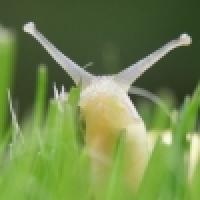
Graphical methods I: Slug wars
Slug world divided
It is 50 million years from now, and slugs rule the Earth. If this sounds funny, imagine how the dinosaurs laughed at the first puny furballs we call "mammals". Slugs are already everywhere and they're probably already better organised than we think.
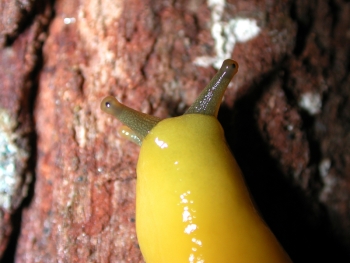
So then, about 1.6 petaseconds from now, slugs rule the Earth. We come across them in a Golden Age of slug science, in which slugtech and slugmed hold great promise for eradicating poverty, hardship and illness throughout the world. However the face of the Earth has changed: continents have twirled and glided in their tectonic dance and now form just two large landmasses, on opposite sides of the planet.
As slugs live longer, populations boom and space is scarce. The societies of each continent eye the other's land greedily. Slug State A (SSA) has heard rumours that Slug State B (SSB) has developed a terrifying new weapon — the Inter-Continental Salty Missile, or ICSM for short — and it too begins a programme of rapid research and construction of ICSMs. Each missile is capable of delivering a Pinch of Salt from one continent to the other and releasing it over a city, causing many thousands of slugs to shrivel and die. What's worse, slugtech is based on compounds which react in a similar way to slugs themselves: an ICSM strike will not only kill slugs, but wipe out buildings and ICSMs on the ground.
It is soon clear that both sides are accelerating the build-up of their arsenals, which leads some slugs to point out that were a Salty War ever to take place, practically every slug on Earth would die. Moreover, in this Brave New World, war isn't declared in the old-fashioned way: SSB could launch a sneaky attack against SSA and wipe out all of its ICSMs before SSA had a chance to respond. SSB's victory would be total. But SSB also fears a sneak attack from SSA, so how can each state ensure that enough ICSMs survive such an attack to inflict unacceptable damage on the attacker? Some slugs claim that introducing a weapon to neutralise incoming ICSMs — the so-called Spoonful of Sugar (SoS) — or carrying multiple Pinches of Salt in each missile (MPSMs) will prompt each state to increase their arsenal. Is this true? What about protective coverings for ICSMs on the ground, the newly-invented CandyFloss? The right answer to such a question could save many slugs; the wrong one could be disastrous.
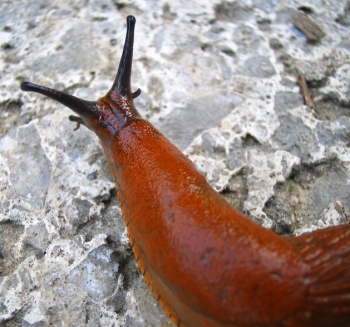
Maths to the rescue
A definitive answer to such questions is difficult for us, never mind the slugs. However, some simple graphical arguments can shed a lot of light on the problems involved. Graphical methods can be useful for mathematicians to get to grips with a complex problem: they can provide strikingly simple ways of depicting complex behaviour, and are also capable of representing complex and copious data in a straightforward way. Moreover, they call on the brain's natural pattern-finding abilities. One of the simplest patterns is a straight line, and it is possible to change the way data is represented to see if a straight line emerges, and then figure out what this means.
Graphical representation of data or behaviour allows for rapid assimilation of the "big picture" and enables one to employ geometric intuition which can lead to physical deductions. There are obvious limitation to the use of graphical methods (for example, they work best when there are only a few variables to consider, and drawing graphs in more than three dimensions can be awkward), but their widespread use in problems of physics, chemistry, biology, statistics, and more proves their utility.
We begin by letting x and y be the number of ICSMs possessed by SSA and SSB, respectively. We're going to cheat a little bit — all in a good cause — and treat x and y as if they were real numbers, rather than the integers they are. Since we are dealing with large numbers, the percentage error associated with treating them as real numbers is quite small, as you can show for yourself.
Increasing and continuous functions
A function h(t) is continuous if there are no gaps or jumps in the graph of its values, in other words if you can draw the graph without taking your pen off the paper (this isn't the formal definition, but it's the essence of it; see this Mathworld entry for a formal definition).
A function is increasing if whenever t2>t1 then h(t2)>h(t1). For example, the function h1(t)=t is both continuous and increasing for all values of t, h2(t)= t2 is continuous for all values of t but only increasing for positive values of t, and h3(t)=tan(t)=sin(t)/cos(t) has a discontinuity whenever cos(t) = 0 .
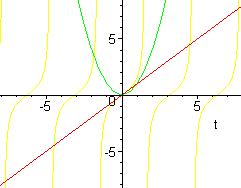
The graphs of h1, h2 and h3 in red, green and yellow respectively.
To start with, we will assume that both states possess identical missiles which are equally unprotected. Remember that each state feels "safe" if enough of their ICSMs survive a sneak attack by the other state, so that they can inflict heavy damage on the attacker. If SSA has x weapons then for SSB to feel safe it has to have at least some minimum number g of weapons. This number g depends on x, so we will write it as g(x). As the number x gets bigger, the number g(x) also increases. In maths speak we say that g(x) is an increasing function of x. We also assume that g(x) is continuous, in other words that there are no jumps or gaps in its graph. (See the box on the right for more about increasing and continuous functions.)
Now SSB feels safe if its own number of weapons, y, is greater than g(x), i.e. if y>g(x). In the same way, SSA feels safe if x>f(y) for some increasing and continuous function f(y). Formulated as a complete mathematical statement, what we have is:
"There must exist two continuous, increasing functions f and g such that SSA feels safe if and only if x>f(y) and SSB feels safe if and only if y>g(x)."
The if and only if in this statements simply means that the implication works both ways: if SSA feels safe then we know immediately that x>f(y), and, conversely, if x>f(y), we know immediately that SSA feels safe. SSA feels safe precisely when x>f(y), and the corresponding statement is true for SSB. This is an important point because not every statement involving an implication is reversible like this: just think of the true sentence if an animal is a dog, then it is a mammal. In this case the reverse, if an animal is a mammal, then it is a dog, is false.
The functions f and g are plotted in figure 1 below.
To see what these graphs tell us, first think about the curve g(x). If a point (xp,yp) lies above this curve, then yp > g(xp). So the point represents a situation in which SSB feels safe. Similarly, you can convince yourself that any point to the right of f(y) represents a situation in which SSA feels safe.
The intersection of the region above g(x) and to the right of f(y) (the shaded region) represents all situations acceptable to slugs in both states, so the number of ICSMs need not increase. It's a stable region. But is there always an intersection? What if the two curves don't meet at all?

Figure 1: For every point (xp,yp) in the shaded region, xp > f(yp) and yp > g(xp).
So the shaded region represents all the situations where slugs in both states feel safe.
Slugs hanging in balance
Well, it turns out that this cannot happen. The main reason for this is that the graphs of the functions f(y) and g(x) each have to have a very particular shape, and this can be proved mathematically. To begin with, let's look at the starting point of each graph. SSA wants to destroy as much of SSB as possible, and the slugs of SSA can work out the number of ICSMs, x0, required to do so. If SSB has no missiles at all, then SSA only needs x0 missiles. The same is true for SSB: there is a number of missiles, y0, that SSB feels it needs to destroy "enough" of SSA. The two points (x0,0) and (0,y0) represent the start of the curves x=f(y) and y=g(x), respectively.
A little thought shows that there are only three types of continuous increasing curves, which are drawn in figure 2. The green curve gets steeper and steeper as y increases, and so we can call it an acceleratingly increasing curve (this isn't the formal term). The steepness of the blue curve, on the other hand, decreases so we can call it a deceleratingly increasing curve. The straight red line has constant slope: it increases steadily. Of course, the lines could accelerate or decelerate their steepness at different rates, or the straight line be more steep or less so, but there are only these three basic types of continuous increasing curves to consider.
You can convince yourself that if f(y) is acceleratingly increasing and g(x) is deceleratingly increasing then the two curves definitely meet, and a stable region exists. In fact, the two curves meet in exactly one point which we have labelled (xm, ym) in figure 1, and which is called the minimum stable point.
So proving that there is a stable region in which neither state needs to increase its arsenal now reduces to proving that each of f(y) and g(x) has the required shape. And this can be done using some reasonably basic mathematical techniques. We have included the proof for those who are interested. Amazingly, a bit of maths can show that there's still hope for slug world!

Figure 2: The green acceleratingly increasing curve gets steeper as y increases,
while the steepness of the blue deceleratingly increasing curve decreases.
Defence tactics
We will now go on to look at how the graph is changed by the introduction of various forms of defence, but in each case the two curves are of the same shapes as drawn in figure 1, and so there will be just one minimum stable point. We'll ask how the position of this unique point is influenced by the defence tactics of each state.
First we ask what happens should SSA defend its missiles with CandyFloss or Spoonsful of Sugar. If each missile is better protected, then the probability of any particular missile belonging to SSA suriving an attack is increased.
The probability of a missile surviving an attack can be built into the mathematical analysis of the problem. In fact, it appears in the proof that f(y) is acceleratingly increasing and g(x) deceleratingly increasing. If you've read that proof, you can quite easily see that raising this probability means that the curve f(y) moves to the left with the point (x0,0) fixed (here is a more detailed explanation). We've drawn the old situation in black in figure 3, and this new curve in red. The good news from this graph is that the minimum stable point has moved to the left and down: both states need fewer ICSMs for stability. Protecting your missiles is a good thing for all concerned.

Figure 3: If SSA protects its missiles, then f(y) (the red curve)
moves to the left and g(x) (the blue curve) moves up.
Now we suppose that SSA protects its cities and their sluggy denizens by means of SoSs, CandyFloss, or some yet-to-be-invented piece of slugtech. Then SSB needs to launch more ICSMs in a sneak attack in order to inflict unacceptable damage on SSA. This means that the entire curve g(x) moves upwards as is shown by the blue curve in figure 3. Look at the new minimum stable point: now both states require more missiles for stability. Bad news for the Campaign for Salty Disarmament.

We can also ask what happens if the missiles are converted to MPSMs (Multiple Pinches of Salt in each Missile). The implications of this change are a bit more complicated to trace, so take a deep breath and sharpen your pencil. If SSA fits its missiles with multiple pinches of salt, then fewer of them need survive SSB's sneak attack. In fact, if N pinches of salt are fitted in each missile, then only about x0/N missiles need survive. This moves the entire curve x=f(y) to the left, as we show in blue in figure 4. But if SSB simply launches the same number of single-pinch missiles at SSA, then it is suddenly faced with N times as many pinches of salt surviving its sneak attack. This is like relabelling the tick marks on the x-axis with numbers increased by a factor of N; in other words, the x-axis gets compressed by a factor of N. If you give some thought to what this relabelling means, you'll see that if we want to plot the new curve y=g(x) on the axes we already have, the curve will simply look much steeper and compressed. This is also shown in blue in figure 4. The conclusion is that SSB now requires more ICSMs, and SSA requires fewer. Perhaps this is a good way for SSA to bankrupt SSB and win the war without a grain of salt being spilled. However, the detailed shape of the curves could change this conclusion, and it is here that our graphical analysis begins to lose its power.

Figure 4: The blue curves show the affect of SSA fitting its missiles with multiple pinches of salt.
If SSB also introduces MPSMs then the situation muddies even further. Because the axes of our graphs measure the number of missiles, both countries introducing MPSMs moves (x0,0) and (0,y0) towards the origin. This tends to decrease the minimum stable point. However, a contrasting effect is that — in the way we have just described — f(y) becomes more horizontal and g(x) becomes more vertical, thus tending to increase (xm,ym). Exactly how these two effects interact and change the position of the minimum stable point is beyond the methods we have talked about here, but rest assured that the finest slug minds in the world have pondered the implications.
Postscript: Many slugs and other intelligent life forms have questioned a lot of the assumptions we have used above. You may like to think of such questions for yourself, and wonder what would happen if, for example, the missiles of SSA had shorter range than those of SSB. There are many questions you could think of: slugs of the world will unite to thank you.
In a future article, we will use graphical methods to explore the societal and ecological changes which could follow a major salty conflict.
Author's note: The tone of this article is light-hearted, but the issues in it were obviously inspired by the very real Cold War between the two blocs formed by the USSR on the one hand and the USA and Western Europe on the other. Both blocs possessed nuclear weapons of terrible power, and were quite ready to consider global warfare scenarios in which perhaps billions of human lives were lost and the planet's ecosystem rendered incapable of supporting life in the way we know it for centuries, if not longer. A series of Strategic Arms Limitation Talks (an ironic acronym in the context of this article) have reduced these nuclear arsenals but despite the end of the Cold War, two striking facts remain: there are tens of thousands of nuclear weapons in several states around the world, and the only country ever to have been attacked by nuclear weapons, Japan, is the world's most determined advocate of disarmament.
This article is part one of a series on graphical methods (and slugs!) by Phil Wilson. You can read more in Graphical Methods II: The return of the slime, and Graphical methods III: the slugs bounce back.
About the author
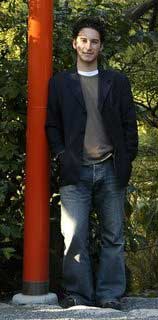
Phil Wilson uses mathematics to understand how the skin of red blood cells works. The people he works with at the University of Tokyo hope that they can use this understanding to invent better ways of delivering medicine to the body. He is suspicious of the organised activities of all gastropods.